|
|
|
|
Alphabet and Language:
Unusual "documents" with Etruscan words
1.
Gold plaques from the Etruscan port city of Caere, discovered only in
1964.
2.
The Mummy of Zagreb
3.
A tile from Capua, in southern Italy. Inscribed with about 300
readable words, the inscription is a genealogy of gods and goddesses descended from the
Etruscan goddess Aph.
|
|
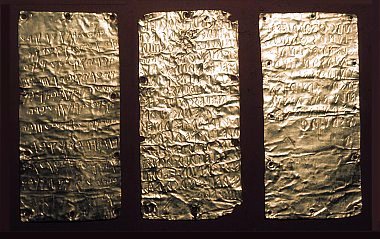
Gold Plaques of Pyrgi (Caere)
in Etruscan and Phoenician languages.
Etruscan. 500 BC. Gold. Museo Villa Guilia, Rome.
|
|
|
|
|
|
|
|
|
4. The Roman Emperor Claudius
was practically the last
known person of the Roman ruling classes who could read Etruscan.
Claudius wrote
a 20-volume study of the Etruscans, compiled a dictionary,
interviewed elderly Etruscans who still knew the language, and married
an Etruscan as his first wife.
Unfortunately his great history of the Etruscans has been lost to the
modern world.
Sources: Bonfante, Laura, The Etruscan Language (1983)
|
|

Roman Emperor Claudius.
Idealized. |
|
|
|
|
|
|
|
|
Architecture
The Etruscans introduced tiled roofs
to Italy. Tiled roofs protected the
perishable wooden building underneath.
The notable contribution made by the Etruscans was to lay down
rectangles of tile across the roof, then overlap half-round tiles on
top, along the seams of the rectangles--an ingenious seal. |
|

A terracotta roof tile, schematic |
The ends of the tiles along the roof line were sealed with
fierce-looking antefixes. |
|
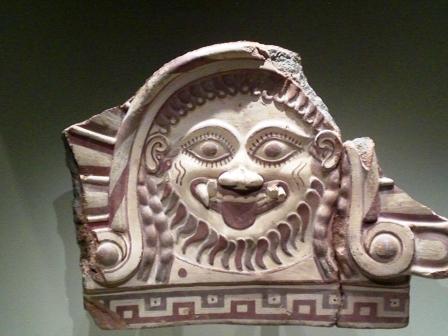
Antefix: Gorgon or Medusa.
Etruscan.
5th c BC.
Terracotta. Getty Villa.
|
|
|
|
|
|
|
|
|
Art
The Etruscans so loved the Greeks that it's not easy to define differences
between Greek art and Etruscan art.
More
Greek vases have been found in Etruscan tombs and sites than have been
located in Greece itself.
About 500,000 Etruscan tombs are in southern Etruria alone.
In this typical Etruscan vase, you can clearly see Greek
mythology ("Hercules Slaying the Hydra") and Greek vase design.
Sources: Richard de Puma,, Etruscan Art
in the Metropolitan Museum (2013) Nigel, Spivey,
Etruscan Art (1997)
|
|
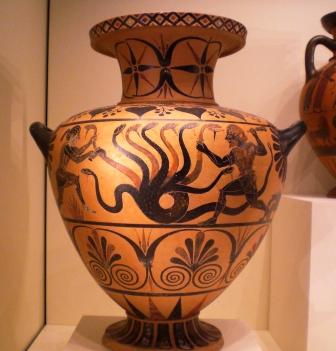
Vase : Hercules Slaying the Hydra.
Etruscan.
5th c BC. Terracotta. Getty Villa
|
|
|
|
|
|
|
|
|
Beliefs
One belief the Etruscans evidently held was
predestination: each civilization had only a specified lifespan.
Theirs was allocated eight centuries, ("saecula"). which ran out in the
1st c BC. At that point, they more or less gave in to the Roman armies,
believing Rome's turn had begun.
The Romans found the Etruscans' religious
beliefs alien. They also found it very powerful.
After the
assassination of Julius Caesar, the Roman authorities, taking no chances
with the gods, summoned the Etruscan diviner Vulcanius to Rome.
The Romans wanted him to make sense of the conjunction of Caesar's death with
the pass-by of a comet. Vulcanius pronounced the end of the 9th Etruscan period and the beginning of the
10th, or last. That is, the end of the world, even for the Romans.
Vulcanius proved to be spectacularly wrong.
|
|
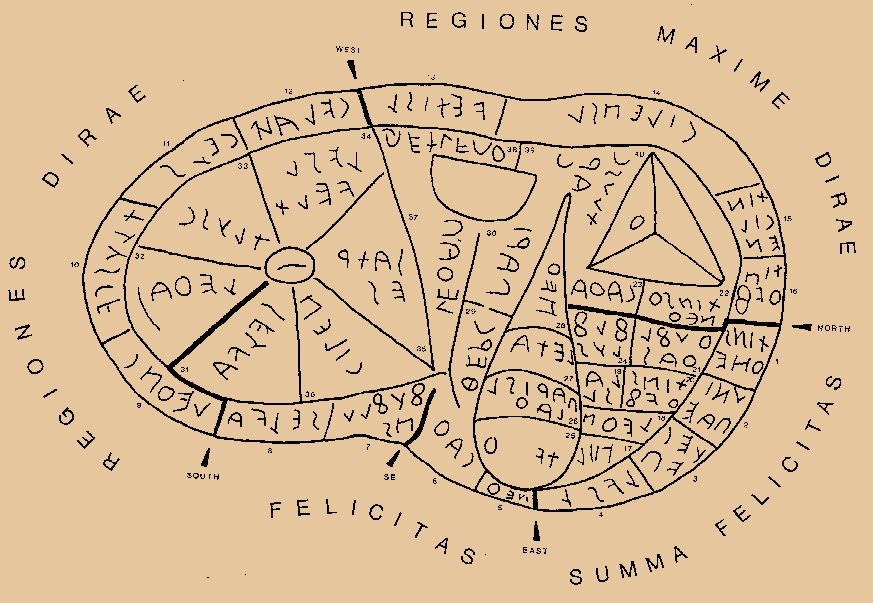
The Liver of Piacenza, a
teaching
tool for Haruspicy.
Etruscan. 2nd c BC. Bronze.
Palazzo
Farnese, the Municipal Museum of Piacenza. Piacenza, Italy. |
|
|
|
|
|
|
|
|
Fashion
Men and women of the upper
classes tended to dress alike. They wore long flowing garments, gold jewelry,
long sandals with upturned toes.
A wealthy, hedonistic look. |
|
 |
|
|
|
|
|
|
|
|
Gladiators
The Etruscans introduced gladiators and gladiatorial-style
combat to ancient Italy. These warriors are more likely boxers.
Note the priest in the upper left, divining something from the flight of
the birds--perhaps the outcome of the fight? |
|
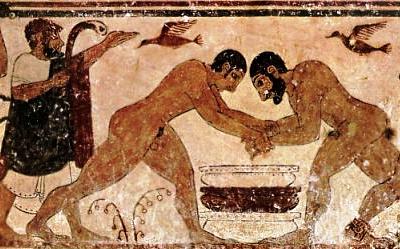 |
|
|
|
|
|
|
|
|
Music and
musical instruments
The Etruscans devised wind, percussion, and stringed
instruments.
Musicians and instruments accompanied the military, providing important
sound signals to the soldiers.
Swineherds kept their animals together with a type of trumpet called a
buccina.
Tomb frescoes depict musicians and dancers in many of the banqueting,
dancing, and games scenes.
What the music sounded like is
unknown, their
musical tradition probably oral.
|
|
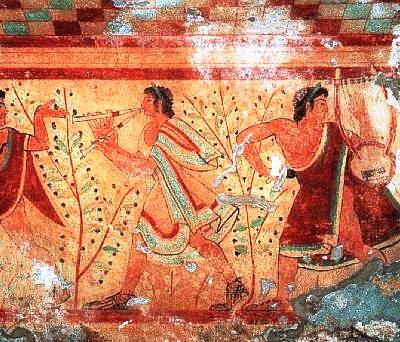
Frescoes.
Etruscan. probably 5th c BC. Tomb of the Lions, Tarquinia, Italy.
Courtesy Mysterious Etruscans. |
|
|
|
|
Numbers
Etruscan dice have been discovered, so they had some kind of
numbering system. It was probably a decimal system.
|
|
|
|
|
|
|
Names
What the Etruscans were
called
The Etruscans called themselves
used the term "Rasenna."
The
Romans called them the “Tusci” or “Etrusci."
The Romans
mocked the Etruscans by calling them pudgy ("pinguis"). Their
obesity was a an index of their decline.
The Greeks used “Tyrrhenioi”
(Tyrrhenians).
What the Etruscans named their children
Girls: Larthi, Velia, Ramtha, Husti, Thania
Boys: Lars or Laris, Vel, Sethre, Arnth, Avle,
Vanth
|
|
|
|
You may contact me, Nancy
Padgett, at
NJPadgett@gmail.com.
Updated August 2015 |
|
|